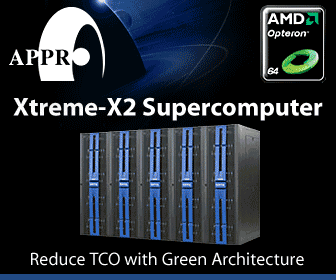GOVERNMENT
Supercomputer Triples Performance with 2,300 Quad-Core AMD Opterons
It’s no secret that supercomputers have long been a force behind enabling critical research in life science, medical, defense and seismic studies, among many other important areas and industries. But in order to crunch numbers at mind-boggling rates, these massive computing clusters demand a significant amount of performance and with it, of course, power. To make matters worse, in order to provide more computing performance to enhance research capabilities, traditional supercomputers typically require lengthy upgrades that can last many months, or even years.  However, this isn’t the case at The Holland Computing Center (HCC) of the Peter Kiewit Institute at the University of Nebraska. By simply upgrading from Dual-Core AMD Opteron processors to 2,300 state of the art Quad-Core AMD Opteron processors (total of 9,200 cores), it took a total of 14 hours to triple its compute capacity – from 21.5 sustained Teraflops to over 60 Teraflops – with no change in HCC’s thermal footprint whatsoever – quite a testament to the significance of the architecture of AMD Opteron processors. More great facts follow within this short video at URL: http://ie.youtube.com/watch?v=psxHwaBY1sA .
However, this isn’t the case at The Holland Computing Center (HCC) of the Peter Kiewit Institute at the University of Nebraska. By simply upgrading from Dual-Core AMD Opteron processors to 2,300 state of the art Quad-Core AMD Opteron processors (total of 9,200 cores), it took a total of 14 hours to triple its compute capacity – from 21.5 sustained Teraflops to over 60 Teraflops – with no change in HCC’s thermal footprint whatsoever – quite a testament to the significance of the architecture of AMD Opteron processors. More great facts follow within this short video at URL: http://ie.youtube.com/watch?v=psxHwaBY1sA .
 However, this isn’t the case at The Holland Computing Center (HCC) of the Peter Kiewit Institute at the University of Nebraska. By simply upgrading from Dual-Core AMD Opteron processors to 2,300 state of the art Quad-Core AMD Opteron processors (total of 9,200 cores), it took a total of 14 hours to triple its compute capacity – from 21.5 sustained Teraflops to over 60 Teraflops – with no change in HCC’s thermal footprint whatsoever – quite a testament to the significance of the architecture of AMD Opteron processors. More great facts follow within this short video at URL: http://ie.youtube.com/watch?v=psxHwaBY1sA .
However, this isn’t the case at The Holland Computing Center (HCC) of the Peter Kiewit Institute at the University of Nebraska. By simply upgrading from Dual-Core AMD Opteron processors to 2,300 state of the art Quad-Core AMD Opteron processors (total of 9,200 cores), it took a total of 14 hours to triple its compute capacity – from 21.5 sustained Teraflops to over 60 Teraflops – with no change in HCC’s thermal footprint whatsoever – quite a testament to the significance of the architecture of AMD Opteron processors. More great facts follow within this short video at URL: http://ie.youtube.com/watch?v=psxHwaBY1sA . 